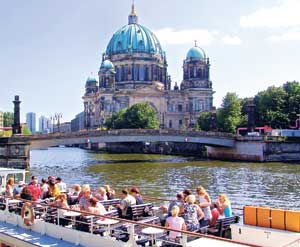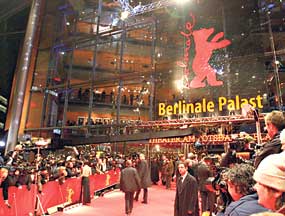
Berlin: Where boredom is not on the mapMovie fans around the world will have their sights fixed on Berlin, and so will tourists, drawn to this huge city with many faces when the 58th Berlin Film Festival takes place from February 7-17. Previews, gala evenings, parallel sections, films from Hollywood, the underground and films d'auteurs – the whole world of the 7th Art will be there in the movie theatres on Potsdamer Platz.
Since German reunification in 1989, Berlin has several central areas. The Charlottenburg castle is the royal centre; Lübars is a veritable village within the city; Potsdamer Platz is the avant-garde face of Berlin; the Museumsinsel (Museums Island) is truly an island of culture; Spandau is bursting with creativity; Kreuzberg has an exotic air while the sporting crowd will gather around the Olympiastadion. A major contribution to the dynamic atmosphere of the city is the vitality of the population. Cultural life is rich, museums are many (more than 150 and some 300 galleries), fashion is important here, and night owls feel right at home. The Tourist Office counts more than 7,500 places to eat, from the traditional to the eccentric. To sum up: Berlin is a place where boredom is not on the map! Information Arrival and departure: Airport – Berlin has 3 airports. General information on air links is available at 0180 500 01 86. Tourist Office: Europa-Center, Budapester Straße, 10787 Berlin, Tel: (030) 25 00 25. Information on site: The bimonthly publications, Zitty and Tip, as well as the monthly Berlin-Programm report on all kinds of upcoming events. The city’s daily newspapers also print calendars of events in a weekly supplement. On the Internet, there is a great deal of information and many useful suggestions for planning a trip to the German capital; recommended sites are: www.berlin.de. www.berlin-info.de, www.meinberlin.de, www.art-in-berlin.de It is a good idea to plan ahead, to get the most out of your trip. In 1989, Berlin became the symbol of the end of the Cold War. The fall of the Berlin Wall was a moment of high drama in the city’s history. Previously, Berlin had been the capital city and seat of government at five separate times. Today, reunified Berlin is once again the capital of Germany. Its history is visible in its architecture: the city has regularly sacrificed its heritage sites to the benefit of progressive ideas, as each new generation seeks to make its mark on the urban landscape. Begin your visit by the Postdamer Platz, where the Movie Festival is held. It represents the legendary Berlin that existed between the two World Wars. Postdam Square was then the busiest intersection in Europe. Your visit will only be complete when you have walked along Unter den Linden to admire the famous Brandeburg Gate. A symbol of Berlin and Prussia, but also of Germany divided and reunited, the Brandeburg Gate, built between 1789 and 1791, was inspired by the Acropolis in Athens.
Then, visit the Charlottenburg Castle and its opulent apartments - one of the most beautiful works of architecture on the western side of the city, particularly The Golden Gallery (1746), one of the finest examples of Rococo style. The Gendarmenmarkt, in Friedrichstadt, will follow: it is considered to be the most beautiful square in Berlin. In 1944, bombs damaged the buildings, dome and theatre, which were rebuilt in the early 1980s. Be sure to see the Schauspielhaus and the Französischer Dom (French Church). The neighbourhood is now home to many ministries. You might finish your tour at Kreusberg, the most central district of the city, that has not changed much over the years. People come to shop at the Turkish market along Landwehrkanal, or to listen to music on Marriannenplatz. Stop in a bar on Oranienstrasse for a drink. It is worth visiting this neighbourhood for its history (it was once surrounded on three sides by the Wall), and to notice today’s east-west divide: the fashionable west with its restored façades and the Mediterranean east with a large Turkish community. Insiders’ Berlin All year long, festivals, fairs, show or sports events add to the charms of Berlin. The International Exhibition Complex includes indeed the largest conference centre in Europe (Internationales Congreß Centrum Berlin) and the Exhibition Grounds (under the Radio Tower). Major cultural and scientific events are held here regularly. Berlin’s theatres and concert halls also offer a wide variety of programmes. The museums of Berlin have unique collections, from antiquities to contemporary art, from Nefertiti to Joseph Beuys. Go straight to Museums Island (Museumsinsel), which is on UNESCO’s World Heritage List. There are fascinating collections there, including royal collections. The old National Gallery and the Bode Museum are worth visiting at night, when they are lit up spectacularly. The first Sunday of the month, entrance to national museums and Museums Island is free of charge. Shopping and nightlife For shopping, the choice is Kurfürstendamm, which merits its international reputation. You can find it all here: Bulgari, Cartier, Chanel, Cerruti 1881, fashions by Benetton and Lacoste, and local designers such as Bramigk and Kuckuck. Be sure to take in the elegant shops of international designers on the side streets such as Fasanenstraße. Nearby, the famous “Kaufhaus des Westens”, generally called the KaDeWe (www.kadewe.de), has been in business for almost a century, selling something like 380,000 items in the eight-storey building. The city’s main store is also Europe’s largest department store. Don’t forget to stop in the famous grocery section. The “Quartier 206” (designed by I.M. Pei, architect of the Louvre Pyramid in Paris) and the “Galeries Lafayette” (look for the glowing cone inside the store, it was designed by Jean Nouvel) in Friedrichstraße are also worth seeing. Little shops in Mitte’s “Hackesche Höfe” neighbourhood of pretty courtyards offer some more unusual and unique designs, extravagant or avant-garde. On weekends, you can try the flea market on Avenue of 17 June (Straße des 17. Juni). You may not find anything you need, but without trying too hard, you’ll find something you want – at a bargain price. In Berlin, you might be surprised to discover that you can have breakfast at any time of day. Night-owls show up in cafés mid-afternoon and have a big, recuperative breakfast, in preparation for the next night of revelry. Night life in Berlin begins in the many cocktail bars, salons and “After-Work-Clubs” and goes until dawn by way of discotheques and clubs. A popular place is the lore.berlin (www.lore-berlin.de). The two lorries parked out front are a reminder of the days when this was a coal cellar. Now a fashionable club serving cocktails from a counter that is 33 metres long! This is the bar for snapping a souvenir photo. Berlin doesn’t have a single district where restaurants and clubs are located. Rather, each neighbourhood has its own selection of bistros, cafés and bars. Whatever your budget, and whatever your pace, you can find something that suits you. The Hackesche Höfe in Mitte, as well as Oranienburger Straße, are good places to start. Another destination, popular with the theatre crowd is the Savignyplatz in Charlottenburg and Winterfeldplatz in Schöneberg. Prenzlauer Berg, famous for Russian and Jewish restaurants, is also high on the list of places to look for a meal. Finally, if you are looking for something trendy, head for Simon-Dach-Straße in Friedrichshain, where the latest fads always begin. The Berlin Festival
The Berlinale or Berlin International Film Festival, which takes place every year in February, is one of the biggest film festivals in the world along with Cannes and Venice. The Festival is open to the public (contrary to Cannes) and is attended by 15,000 specialists (including 3,500 journalists) from 76 countries. The festival’s highest award is the Golden Bear (de Goldener Berliner Bär), while the Silver Bear (de Silberner Berliner Bär) is the award for Best Director (de beste Regie), Best Actress (de beste Darstellerin) or Best Actor (de bester Darsteller). The Berlinale stands out from other film festivals through its resolutely international selections, screening films from all over the world, from former Eastern bloc countries as well as from the West. In 2006, Grbavica: the Land of my Dreams, a Bosnian film, was awarded the Golden Bear. Visit the festival’s official website at: http://www.berlinale.de, |
|| Front
Page | News | Editorial | Columns | Sports | Plus | Financial
Times | International | Mirror | TV
Times | Funday
Times || |
| |
Reproduction of articles permitted when used without any alterations to contents and the source. |
© Copyright
2008 | Wijeya
Newspapers Ltd.Colombo. Sri Lanka. All Rights Reserved. |


